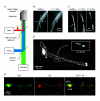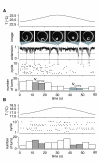The role of the AFD neuron in C. elegans thermotaxis analyzed using femtosecond laser ablation
- PMID: 16600041
- PMCID: PMC1450292
- DOI: 10.1186/1471-2202-7-30
The role of the AFD neuron in C. elegans thermotaxis analyzed using femtosecond laser ablation
Abstract
Background: Caenorhabditis elegans actively crawls down thermal gradients until it reaches the temperature of its prior cultivation, exhibiting what is called cryophilic movement. Implicit in the worm's performance of cryophilic movement is the ability to detect thermal gradients, and implicit in regulating the performance of cryophilic movement is the ability to compare the current temperature of its surroundings with a stored memory of its cultivation temperature. Several lines of evidence link the AFD sensory neuron to thermotactic behavior, but its precise role is unclear. A current model contends that AFD is part of a thermophilic mechanism for biasing the worm's movement up gradients that counterbalances the cryophilic mechanism for biasing its movement down gradients.
Results: We used tightly-focused femtosecond laser pulses to dissect the AFD neuronal cell bodies and the AFD sensory dendrites in C. elegans to investigate their contribution to cryophilic movement. We establish that femtosecond laser ablation can exhibit submicrometer precision, severing individual sensory dendrites without causing collateral damage. We show that severing the dendrites of sensory neurons in young adult worms permanently abolishes their sensory contribution without functional regeneration. We show that the AFD neuron regulates a mechanism for generating cryophilic bias, but we find no evidence that AFD laser surgery reduces a putative ability to generate thermophilic bias. In addition, although disruption of the AIY interneuron causes worms to exhibit cryophilic bias at all temperatures, we find no evidence that laser killing the AIZ interneuron causes thermophilic bias at any temperature.
Conclusion: We conclude that laser surgical analysis of the neural circuit for thermotaxis does not support a model in which AFD opposes cryophilic bias by generating thermophilic bias. Our data supports a model in which the AFD neuron gates a mechanism for generating cryophilic bias.
Figures




References
Publication types
MeSH terms
LinkOut - more resources
Full Text Sources

